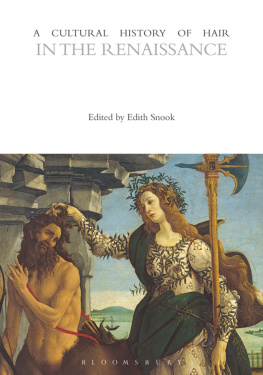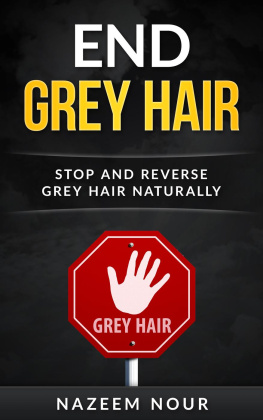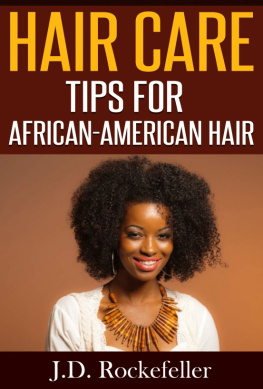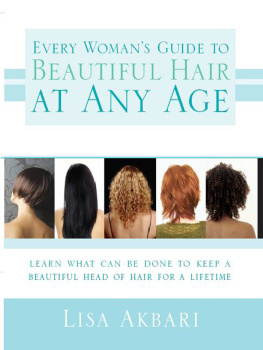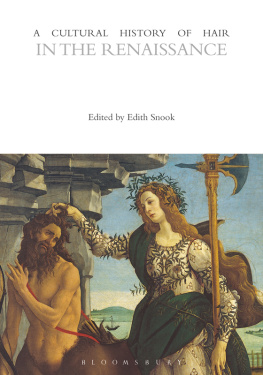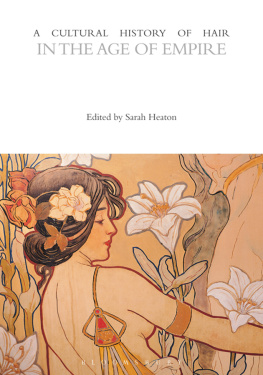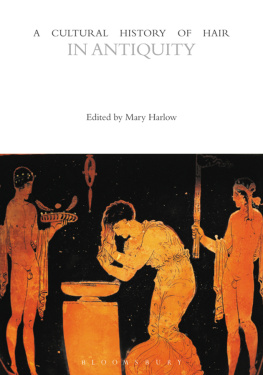A CULTURAL HISTORY
OF HAIR
VOLUME 3
A Cultural History of Hair
General Editor: Geraldine Biddle-Perry
Volume 1
A Cultural History of Hair in Antiquity
Edited by Mary Harlow
Volume 2
A Cultural History of Hair in the Middle Ages
Edited by Roberta Milliken
Volume 3
A Cultural History of Hair in the Renaissance
Edited by Edith Snook
Volume 4
A Cultural History of Hair in the Age of Enlightenment
Edited by Margaret K. Powell and Joseph Roach
Volume 5
A Cultural History of Hair in the Age of Empire
Edited by Sarah Heaton
Volume 6
A Cultural History of Hair in the Modern Age
Edited by Geraldine Biddle-Perry
A CULTURAL HISTORY
OF HAIR

IN THE
RENAISSANCE
VOLUME 3
Edited by Edith Snook

INTRODUCTION
CHAPTER 1
CHAPTER 3
CHAPTER 4
CHAPTER 5
CHAPTER 6
CHAPTER 8
A Cultural History of Hair offers an unparalleled examination of the most malleable part of the human body. This fascinating set explores hairs intrinsic relationship to the construction and organization of diverse social bodies and strategies of identification throughout history. The six illustrated volumes, edited by leading specialists in the field, evidence the significance of human hair on the head and face and its styling, dressing, and management across the following historical periods: Antiquity, the Middle Ages, the Renaissance, the Age of Enlightenment, the Age of Empire, and the Modern Age.
Using an innovative range of historical and theoretical sources, each volume is organized around the same key themes: religion and ritualized belief, self and societal identification, fashion and adornment, production and practice, health and hygiene, gender and sexuality, race and ethnicity, class and social status, representation. The aim is to offer readers a comprehensive account of human hair-related beliefs and practices in any given period and through time. It is not an encyclopedia. A Cultural History of Hair is an interdisciplinary collection of complex ideas and debates brought together in the work of an international range of scholars.
Geraldine Biddle-Perry
EDITH SNOOK
The material culture of the Renaissance includes hair. A substance produced by the body, hair acquired meaning from these visceral origins. That the qualities of a persons hair were in this period thought to be contingent on the bodys humoral balance established hairs signifying power as a visible physical marker of the complexion and, thus, of identity. At the same time, hair was infinitely malleable and was dressed, decorated, shaped, cut, colored, and covered in accord with fashion and individual and communal beliefs about morality and the social order. The very intimate association of hair with the self is confirmed by the way that this connection persisted in the creation of beautiful tools for hair care and in the ways that hair circulated apart from the bodyused in magical incantations, preserved in jewelry, and stitched into art. Although combs and brushes were first of all practical, used for combing and brushing the hair and for nit-picking, they could also become beautiful gifts. That goldsmiths produced brushes and that combs might be carved from ivory, decorated with scenes of David and Bathsheba and the Judgment of Paris, and engraved with text arises from their affective value.).
Naturally growing from the body, hair inspired a culture because it was physically meaningful and significant within a range of social and cultural practices.
The chapters in this book attempt to unite a variety of perspectives on hair. Necessarily interdisciplinary, the history of hair in the Renaissance draws together the histories of fashion, political and religious ideas, gender, science, medicine, art, and literature. Sources documenting hairs history are equally wide-ranging and include the Bible and theological treatises interpreting it for Renaissance audiences, conduct books, professional regulations, life-writing, medical texts, calendars, satirical texts, literature, sculpture, paintings and printed engravings, and material objects. The chapters investigate hairs physiological foundations, as outlined by medical thinkers, and explore the spaces, materials, and people (professional and otherwise) dedicated to hairs care. They consider hairs function as a persistent source of multiple cultural anxieties and as a medium to engage with fashion, to perform ones identity as a writer, and to express social identityincluding national, gender, class, racial, and religious identities. The primary focus of the volume is on the hair of the head, as it is with many of the Renaissance texts documenting hairs history, but body and facial hair are also considered in several chapters. Hair practices, fashions, and technologies shift across this books two-hundred-year time span, as they do across Europes geographical and cultural spaces. Yet some principles do seem to hold. There is a broad attachment to Galenic humoral theory as a means of understanding the body (the challenge of Paracelsian ideas does not appear to have informed thinking about hair to any great degree) and a general commitment to following biblical dictates regarding hair, although doctrinal differences did inform divergent hairstyles. Before the Reformation and after, European dress practices often included a faith-based dedication to rendering womens hair culturally invisible through the wearing of head coverings, a practice which, nevertheless, disappeared for elite women towards the end of the period explored by this volume. Despite these commonalities, however, hair fashions and styles, the anxieties they incited, and its meanings are contextual, informed by particular moments in time, by individual perspectives, and local cultures. An edited collection is for these reasons a productive medium for the study of hairs history, with each contributor bringing a distinct area of expertise to an element of the story of hair in Renaissance Europe.
The chapters in this volume build on existing scholarship around hair. Scholars have written about fashionable hairstyles, the guilds of barbers and barber-surgeons, beards, baldness, and hirsuteness, and about the aesthetic representation of hair in literature, painting, and sculpture. Richard Corsons encyclopedic Fashions in Hair: The First Five Thousand Years surveys the multiple styles adopted by men and women across a broad swath of western history.
Scholars have also considered artistic renderings of hair. Sefy Hendler, for instance, discusses how for both painters and sculptors in Renaissance Italy representing hair and beards was a touchstone for the demonstration of artistic skills.
Because of the parameters of the series, when the hair of people in the world outside of Europe appears in this book, it is for the most part through representations created by Europeans, which reveals more about emerging discourses of race, imperialism, colonialism, and slavery than it does about how non-European peoples viewed their hair. Alf Hiltebeitel and Barbara D. Millers Hair: Its Power and Meaning in Asian Cultures (1998) includes the historical study of hair in Asian culture, while Ayana B. Byrd and Lori L. Tharpss Hair Story: Untangling the Roots of Black Hair in America (2001) and Roy Sieber, Frank Herreman, and Niangi Batulukiss collection
Next page
